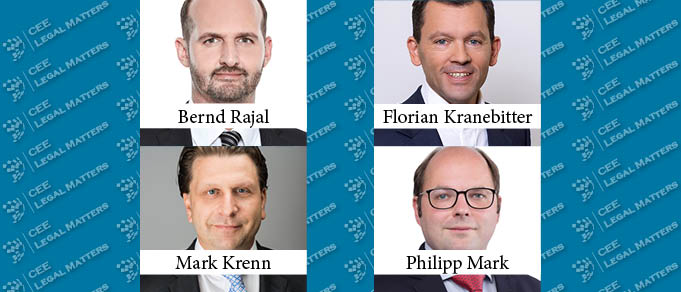With the world slowly reaching what many scientists label “a point of no return” for climate change, countries worldwide are doing their best to combat environmental damage. To that end, the European Union has developed climate and energy targets for the upcoming decade, stating that it is “vital that we direct investments towards sustainable projects and activities.”
To achieve this, the EU devised a “common language and a clear definition” of what exactly that means – what is sustainable, what is green, and how those should be approached at the EU level. This language is presented in the form of an action plan on financing sustainable growth – an EU Taxonomy. It has finally come into play at the start of 2022.
Initial Reaction in Austria
Cerha Hempel Real Estate Partner Mark Krenn, for one, believes that the Taxonomy will create a considerable change in the way sustainable investments are perceived. “Even though it would appear that a number of businesses in Austria are, to an extent, underestimating the potential impacts of the Taxonomy, I believe that it will have a huge impact,” he says.
“Investors will increasingly look for sustainable investments and will do their best to comply – this will set them apart from their competition,” Krenn says. He believes this to be the case, perhaps more than in other markets, especially in real estate. “Real estate investments are long-term investments: when your primary business is investing in long-term products, you do everything you can to grasp all aspects of all legal frameworks that apply. For example, if you invest in an office complex that you wish to market in several years, you need to know whether, a few years down the line, that investment will register as green or not.”
CMS Capital Markets Partner Philipp Mark also believes that the Taxonomy is a positive change. “It’s a good thing to have such an initiative on an EU level, not just on a local one,” he says.
FWP Partner Florian Kranebitter, an ESG expert, believes that the market is, in fact, ahead of the legislative initiative. “The six pillars of the Taxonomy do the groundwork, of course, but the industry and all interested stakeholders are far ahead in their thinking. We’ve seen this in practice, with an increase in ESG-related client inquiries lately,” he says. Kranebitter believes that this is a sign of a positive market rhythm.
“The Taxonomy has become a significant opportunity for Austrian businesses, and law firms have been increasingly engaged in providing ESG-related advice, especially for environmental aspects,” agrees Bernd Rajal, Schoenherr Partner and Head of the firm’s Regulatory and Energy team. According to Rajal, the real issue here is the “challenging renewable energy targets that the Austrian government has set for 2030. It will be most interesting to see how the markets adapt to these targets and overall trends, as more and more investments begin to flow in, especially in wind and photovoltaic energy,” he says. Rajal expects the energy transition to more sustainable sources to mark the following decade.
Are Gas and Nuclear Power Green Now?
However, there are significant concerns as well. “There are some inconsistencies in this initiative,” Mark says. “There is an issue with gas and nuclear power and the fact that these energy sources have been labeled transitionally green.” He says that the Austrian market is “not used to labeling nuclear energy as green” and that this could present an obstacle.
Indeed, Rajal and Kranebitter agree, with Rajal adding that “nuclear is a no-go for the entire Austrian economy – in fact, there is a statutory ban on nuclear plants in Austria. The stance of the Austrian government on this matter significantly differs from general guidelines and initiatives coming from Brussels – which could prove to be a problem.”
“With the Austrian economy being a nuclear-free one, the government has immediately issued statements and expert opinions on the matter,” Kranebitter says. “However, looking at the criteria for something being green or not, it is also important to take into account that there are vast industry-specific differences out there.”
Kranebitter believes that, ultimately, it will be on businesses themselves to adapt and alter their business models to stay compliant and, therefore, competitive at the same time. “It will be extremely difficult for the oil & gas industry, for example, to make the necessary changes. Unless the companies operating in this field engage in drastic overhauls, staying afloat could be all but impossible,” he adds. “Transferring certain businesses to other entities, in an effort to reshuffle business structures and appear more green is one way of going about it, but it is very much unclear if this would work for businesses – and these loopholes could, of course, be closed by the EU soon.”
On the other hand, there are specific questions related to gas supplies. “With the current crisis in Eastern Europe and the Ukrainian conflict ongoing, natural gas supply will be in question,” Rajal says. “However, it has already been in the works, in Austria, to have natural gas slowly phased out – these plans are, now, likely to accelerate.”
Kranebitter, too, feels that the continuing conflict between Ukraine and Russia is adversely impacting the situation in Austria. “We’ve seen a sharp rise in gas demand ever since the conflict started. Austria has, traditionally, built up a heavy dependency on Russian gas – this state of affairs is likely to change,” he says. “It is likely that this situation with supply will overshadow all other talks when it comes to gas.”
The Risk of Falling Through the Cracks
In addition to material challenges, there are also more formal ones – bureaucracy, administration, and paperwork. “Some market participants, in my view, are not well prepared to begin operating under the Taxonomy framework,” Mark says. “Speaking from a capital markets perspective, I can say that there are somewhat illogical approaches to delineating which businesses must report within the ESG framework and which are left out.” Mark explains that there is a prerequisite mandating that a business must be a large or “capital market-oriented” company to be required to perform ESG reporting.
“In practice – say you operate a small wind-power company trying to make its way in the market, but you are not listed and have not issued bonds – this means that you are not covered by the green initiatives and have no reporting obligation,” Mark says. “Without wind power being labeled as being outright green, certain businesses might fall through the cracks and have a tougher time when applying for bank loans. Not to mention an increased cost level for performing these reports and the chance to be labeled as not green in the bank’s investment portfolio,” he stresses. “Reporting in accordance with the Taxonomy framework is a burdensome exercise. What’s more, there are a lot of wind power companies in Austria that do not qualify for reporting from the get-go. With all the uncertainties surrounding ESG right now, it is not clear if the banks will consider it sufficient, from a financing perspective, if these companies report on a voluntary basis,” Mark says.
Rajal agrees that more clarity and specific definitions would be helpful. “The Taxonomy regulation only provides guidelines for the technical criteria to have something be qualified as sustainable – but these are quite general principles. The criteria are not all sufficiently clear and defined and further guidelines would not only be welcomed but are, in fact, quite needed to create more investor confidence, ultimately,” he says. “This could prove a challenging point if these clarifications are not provided on an EU level. In that case, it would be critical that countries establish similar approaches – to prevent companies from cherry-picking when deciding where to set up shop,” Rajal explains.
One thing is certain – transferring to an ESG-compliant product base will not be costless or easy. Krenn, for one, goes as far as to venture that the European Central Bank will adopt a two-tier interest rate system, to stimulate the switch. “I could imagine, easily, that the ECB establishes a system within which ESG-compliance is stimulated with a lower interest rate.”
The New Reality
“The market will be able to sustain the next taxonomy reality. That’s a fact,” Mark says. “The shift towards renewables has been present for a while now, across all stakeholder groups. Still, to achieve all climate goals, carbon dioxide emissions would have to drop further.” Mark believes that large market players have “a lot of capacity” to adhere to the taxonomy principles. “Even major companies with a traditionally rigid attitude towards change are transforming their energy consumption practices to go more green.”
Kranebitter and Krenn agree with Mark, with Kranebitter saying that the time has come for a lot of companies to start “playing by the rules. For example, OMV – the largest oil importer and refiner and gas distributor in Austria – has begun altering its business model in the past year or so to prepare for the new, green(er) reality.” Kranebitter further explains that businesses that cannot modify their operational models to a sufficient extent are likely to engage in the “organic acquisition of strategic assets, to offset their current position.”
Krenn, too, feels that the market players will not be “squeezed out. There are already plenty of reporting obligations for many companies – just look at what the GDPR brought,” he says. And in contrast to data protection, Krenn believes that “sustainable investments are much more important for everyone. Of course, it may seem burdensome at first, but it will move past this point, and I expect the demand for sustainable investments to grow significantly.”
Rajal seconds the GDPR comparison made by Krenn. “It will be different to GDPR because the entire economy has a stronger commitment towards ESG goals, which should reflect on overall compliance. Not to mention how being green is excellent marketing,” he adds with a smile. Against that backdrop, according to Rajal, “there will be a push, even, to overhaul target companies post-acquisition and make them greener too, via establishing recycling systems, improving waste management, or reducing water usage.”
As an example of this practice, Rajal points to the energy sector, saying that “big industrial operators in Austria are already looking for corporate power purchase agreements with wind parks and solar parks being constructed on-site to provide for the energy requirements of, say, an industrial facility.” He believes this only goes to show the high level of devotion to ESG targets, despite the higher costs associated with this type of product.
Obstacles Will Be Overcome
What will the immediate future look like for the Austrian market? “For this year,” Krenn says, “I expect that we will see a lot of learning across all industries and real estate, in particular.” He feels that businesses will have a steep learning curve and that, much like with the GDPR, there will be a high number of sustainable transformation overhauls in a short period of time. “Especially so – given the current crisis in Ukraine and the shift away from Russian gas – I feel that renewables markets are going to explode.”
Mark finds it harder to make any predictions. “It’s hard to predict – even for the legal market, the most I can say is that the working environment for lawyers will change. In what way – it’s tough to call,” he says. As for businesses, Mark explains that the high number of risk factors could slow down the adoption process. “There are disclosure requirements that will have to become a normal part of doing business – not just contractual disclosures, but financial as well – which will, at least initially, slow down some business operations.”
However, Mark does report that there are initiatives on the way which seek to specifically address this. “In connection with the European Green Bond Standard, a system of ESG rating agencies for businesses, likely based on a registration regime, is in the works. Still, these agencies are not very likely to appear soon, meaning that it will be difficult for lawyers to help their clients navigate the status quo,” he concludes.
Kranebitter believes that the reporting obstacles will be overcome, no matter how troublesome. “Some of the market participants are already facing green reporting requirements – like banks that must report on a Green Asset Ratio when it comes to their portfolios,” he says. “Of course, different stakeholders will be facing different obstacles, but there is a palpable desire from all to do more than the bare minimum.” If these practices go above and beyond, there is a possibility of a positive ripple effect in corporate behavior: “This is, in my opinion, a good thing because – until such a time when we have quite clear, specific, and defined rules on all ESG-related aspects – companies will rely the most on market practices.”
But it will not be the same for all. “The bigger companies will be able to soak the immediate cost increase way better,” Rajal says. “This could prove to be a key market differentiator for some, especially in those sectors where an investment goal transformation would lead to prohibitive cost levels.” He believes that this could lead to more companies applying for state aid and relief packages – something which has been visible on the markets already in the wake of the pandemic. “Regardless of all that, however, I do believe that things will get better after any initial disruptions – the Taxonomy is a step in the right direction, and complying with it could have major positive impacts on our climate and, ultimately, on all of our lives,” Rajal concludes.
This Article was originally published in Issue 9.3 of the CEE Legal Matters Magazine. If you would like to receive a hard copy of the magazine, you can subscribe here.

























